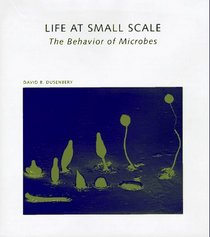Helpful Score: 2
This book is beautiful. The full colour illustrations are stunning. It is written in nontechnical language and on a level similar to a PBS NOVA special. While it explains things in plain English, it isn't dumbed down. The book is divided into 10 chapters:
1 - Invisible Organisms - introduces us to the microscopic world.
2 - Locomotion Without Legs - explains how microscopic organisms move and what unique challenges they face.
3 - Catching a Ride - details the ways an organism can be dispersed that are beyond its control, such as by wind, gravity, and on host animals.
4 - Navigating Through a Chemical Sea - is an introduction to the incredibly complex environment microscopic organisms live in and how they sense and react to their environment.
5 - Vertical Migration - deals with organisms living in large bodies of water or in the soil; it explains how they know where their are going even though they cannot see.
6 - Stationary Feeders - shows that you needn't move to get your food and explains the feeding strategies of such organisms as fungi, symbiotic bacteria, plants, and more.
7 - Resisting Others - is a very introductory look at immune systems.
8 - Communicating Without Sound - explains methods of communication, such as bioluminescence.
9 - Anticipating the Future - delves into the mysteries of the circadian rhythm, our own internal clock.
10 - Learning - takes an introductory peak into the learning and behaviour of micro-organisms.
The book also includes a list for further reading and an index. Although the book was published many years ago (1996), I feel that it has held up well and is not outdated. People without technical expertise in these fields will find it to be an excellent introduction.
1 - Invisible Organisms - introduces us to the microscopic world.
2 - Locomotion Without Legs - explains how microscopic organisms move and what unique challenges they face.
3 - Catching a Ride - details the ways an organism can be dispersed that are beyond its control, such as by wind, gravity, and on host animals.
4 - Navigating Through a Chemical Sea - is an introduction to the incredibly complex environment microscopic organisms live in and how they sense and react to their environment.
5 - Vertical Migration - deals with organisms living in large bodies of water or in the soil; it explains how they know where their are going even though they cannot see.
6 - Stationary Feeders - shows that you needn't move to get your food and explains the feeding strategies of such organisms as fungi, symbiotic bacteria, plants, and more.
7 - Resisting Others - is a very introductory look at immune systems.
8 - Communicating Without Sound - explains methods of communication, such as bioluminescence.
9 - Anticipating the Future - delves into the mysteries of the circadian rhythm, our own internal clock.
10 - Learning - takes an introductory peak into the learning and behaviour of micro-organisms.
The book also includes a list for further reading and an index. Although the book was published many years ago (1996), I feel that it has held up well and is not outdated. People without technical expertise in these fields will find it to be an excellent introduction.




